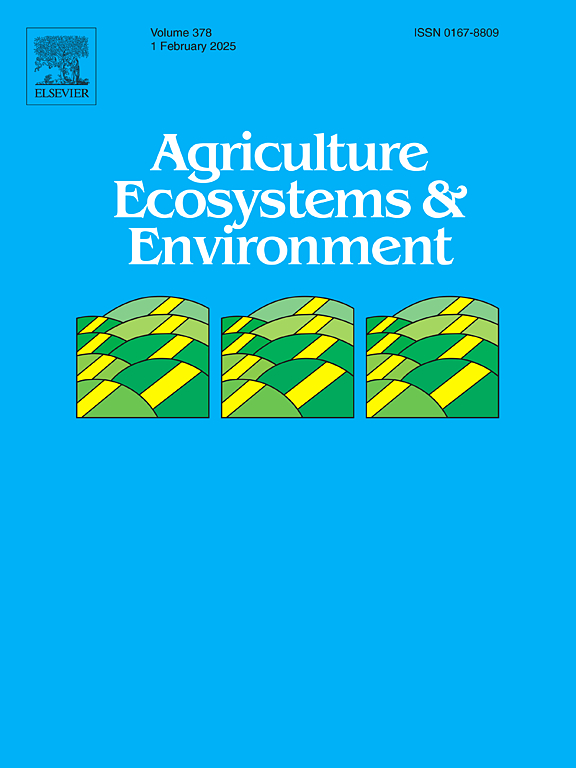在减少施肥时间的同时,减少3,4-二甲基吡唑磷酸和3,4-二甲基吡唑琥珀酸在安多索田里维持白菜产量的氧化亚氮排放
IF 6.4
1区 农林科学
Q1 AGRICULTURE, MULTIDISCIPLINARY
引用次数: 0
摘要
以前的研究报道,硝化抑制剂是有效的减少一氧化二氮排放。然而,没有研究报道3,4-二甲基吡唑磷酸和3,4-二甲基吡唑琥珀酸在安多酚田的有效性。为此,在3年的6个种植季中,研究了硝化抑制剂双氰胺、3,4-二甲基吡唑磷酸和3,4-二甲基吡唑琥珀酸对大白菜产量、氮素利用效率、土壤无机氮、氧化亚氮排放和甲烷吸收的影响。结果表明,双氰胺仅在低于20℃和相对干燥的条件下抑制硝化作用,而在较高温度和高降雨量条件下则无抑制作用。相比之下,3,4-二甲基吡唑磷酸和3,4-二甲基吡唑琥珀酸在所有作物季节都能有效抑制硝化作用。3,4-二甲基吡唑磷酸和3,4-二甲基吡唑琥珀酸能有效减少一氧化二氮的排放(P <; 0.05),而双氰胺则不能。施用硝化抑制剂不影响土壤对甲烷的吸收。施用硝化抑制剂虽然不能提高白菜产量和氮素利用效率,但可以减少施肥时间(即尿素施两次肥,而硝化抑制剂只施一次基肥)。此外,3,4-二甲基吡唑磷酸和3,4-二甲基吡唑琥珀酸即使在较低的硝化抑制剂用量(施氮量的0.5 %)下也能保持产率。此外,前者即使在低施氮量(175 kg N ha - 1,当地标准施氮量250 kg N ha - 1的70 %)下也能保持产量。结果表明,硝化抑制剂有效缩短了施肥时间,节约了人工成本。特别是3,4-二甲基吡唑磷酸酯比常规氮肥用量降低30% %。这些结果表明,3,4-二甲基吡唑磷酸和3,4-二甲基吡唑琥珀酸的应用可以有效地保证产量,减少氧化亚氮的排放,同时节省人工成本。本文章由计算机程序翻译,如有差异,请以英文原文为准。
Mitigation of nitrous oxide emissions by 3,4-dimethylpyrazole phosphate and 3,4-dimethylpyrazole succinic acid with reduced fertilizer application time while maintaining cabbage yield in Andosol fields
Previous studies have reported that nitrification inhibitors are effective in reducing nitrous oxide emissions. However, no studies have reported the effectiveness of 3,4-dimethylpyrazole phosphate, and 3,4-dimethylpyrazole succinic acid in Andosol fields. Thus, the effects of nitrification inhibitors—dicyandiamide, 3,4-dimethylpyrazole phosphate, and 3,4-dimethylpyrazole succinic acid—on cabbage yield, nitrogen use efficiency, soil inorganic nitrogen, nitrous oxide emissions, and methane uptake were investigated in Andosol fields for six crop seasons over three years. The results showed that dicyandiamide inhibited nitrification only at temperatures lower than about 20°C and under relatively dry conditions but not at higher temperatures or under high rainfall. In contrast, 3,4-dimethylpyrazole phosphate and 3,4-dimethylpyrazole succinic acid effectively inhibited nitrification for all crop seasons. 3,4-dimethylpyrazole phosphate and 3,4-dimethylpyrazole succinic acid were effective in reducing nitrous oxide emissions (P < 0.05), but not dicyandiamide. Nitrification inhibitor application did not affect methane uptake by soil. Even though nitrification inhibitor applications did not increase the cabbage yield or nitrogen use efficiency, they could reduce the fertilizer application time (i.e., two fertilizer application times for urea vs only one basal fertilizer application time for nitrification inhibitor treatments). Additionally, 3,4-dimethylpyrazole phosphate and 3,4-dimethylpyrazole succinic acid maintained the yield even at a low nitrification inhibitor rate (0.5 % of applied nitrogen). Moreover, the former maintained yield at even a low nitrogen rate (175 kg N ha−1, 70 % of the local standard application rate of 250 kg N ha−1). Our results demonstrated that the nitrification inhibitors were effectively reduced the fertilizer application time, thus saving labor costs. Particularly, 3,4-dimethylpyrazole phosphate could reduce the nitrogen rate by 30 % compared to conventional nitrogen rates. These results suggested that 3,4-dimethylpyrazole phosphate and 3,4-dimethylpyrazole succinic acid application can be an effective way to ensure yield and reduce nitrous oxide emissions while saving labor costs.
求助全文
通过发布文献求助,成功后即可免费获取论文全文。
去求助
来源期刊

Agriculture, Ecosystems & Environment
环境科学-环境科学
CiteScore
11.70
自引率
9.10%
发文量
392
审稿时长
26 days
期刊介绍:
Agriculture, Ecosystems and Environment publishes scientific articles dealing with the interface between agroecosystems and the natural environment, specifically how agriculture influences the environment and how changes in that environment impact agroecosystems. Preference is given to papers from experimental and observational research at the field, system or landscape level, from studies that enhance our understanding of processes using data-based biophysical modelling, and papers that bridge scientific disciplines and integrate knowledge. All papers should be placed in an international or wide comparative context.
 求助内容:
求助内容: 应助结果提醒方式:
应助结果提醒方式:


